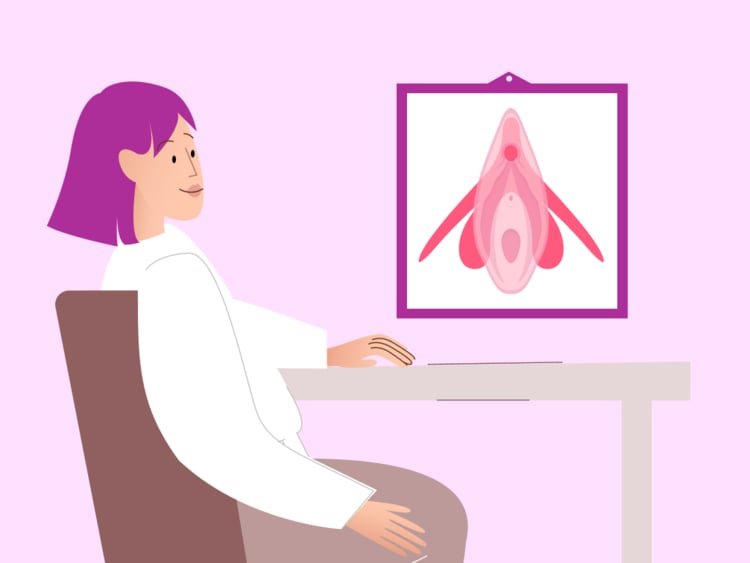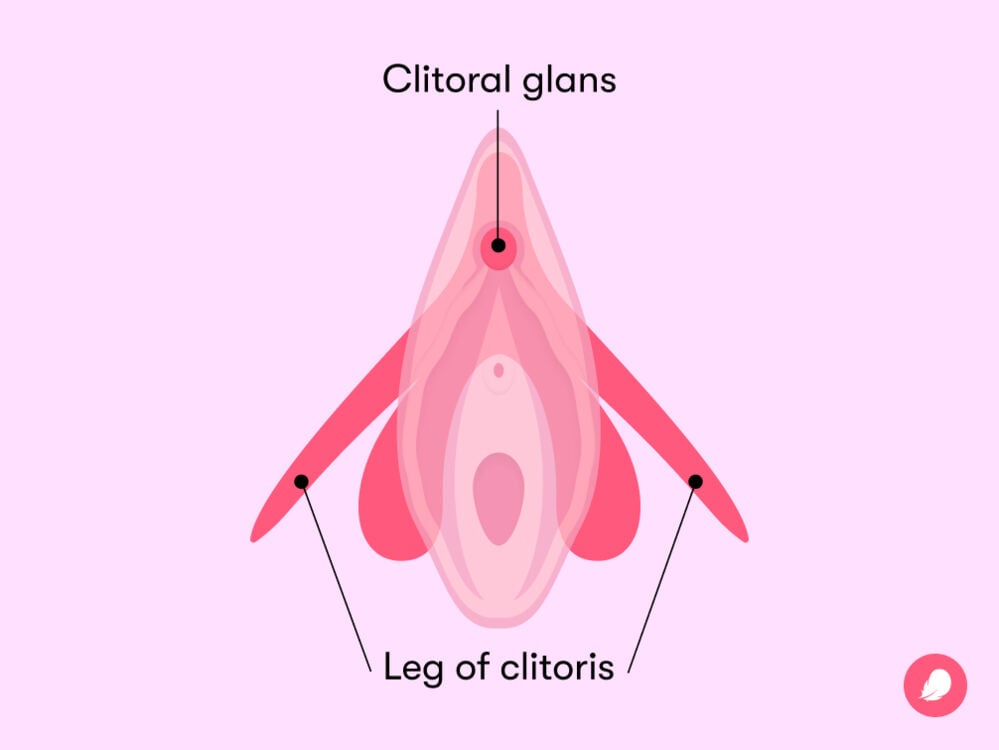Your clitoris has the most nerve endings of any organ in the body, and its sole purpose is to bring you pleasure. But if you aren’t sure where exactly your clitoris is, you’re not the only one. Here’s everything you need to know about the clitoris.
-
Tracking cycle
-
Getting pregnant
-
Pregnancy
-
Help Center
-
Flo for Partners
-
Anonymous Mode
-
Flo app reviews
-
Flo Premium New
-
Secret Chats New
-
Symptom Checker New
-
Your cycle
-
Health 360°
-
Getting pregnant
-
Pregnancy
-
Being a mom
-
LGBTQ+
-
Quizzes
-
Ovulation calculator
-
hCG calculator
-
Pregnancy test calculator
-
Menstrual cycle calculator
-
Period calculator
-
Implantation calculator
-
Pregnancy weeks to months calculator
-
Pregnancy due date calculator
-
IVF and FET due date calculator
-
Due date calculator by ultrasound
-
Medical Affairs
-
Science & Research
-
Pass It On Project New
-
Privacy Portal
-
Press Center
-
Flo Accuracy
-
Careers
-
Contact Us
Everything you need to know about the clitoris


Every piece of content at Flo Health adheres to the highest editorial standards for language, style, and medical accuracy. To learn what we do to deliver the best health and lifestyle insights to you, check out our content review principles.
Ah, the clitoris. You might have heard about this part of the female anatomy talked about in movies and on TV as if it’s some kind of mystery. Where is the clitoris, and what does it do? But its job is actually pretty straightforward.
You can think of it as the feel-good center of the vulva and vagina. That’s because it’s the only part of the human body that is designed solely for pleasure — it literally has no other purpose. Pretty cool, right?
Considering how important it is for pleasure, you’re probably going to want to know exactly where the clitoris is. But if you aren’t quite sure of that or what it looks like, then you’d be forgiven. The clitoris is often presented as a mysterious and out-of-reach thing, and for that reason, your sex education class may have left it out entirely.
However, as a key part of your anatomy, the clitoris shouldn’t be ignored. Here, two Flo experts break down everything you need to know about the small but mighty organ.
Firstly, what is a clitoris?
Since the clitoris is a part of your body, you might feel a little silly asking where it is. But with female pleasure having long been seen as taboo, it’s often not spoken about publicly. The result? It’s completely normal not to know basic information about it.
But because it’s super important that you understand the different parts of your vulva, let’s look into it. Your clitoris can be found just above the opening to your urethra (the tube that you pee out of), which is above the opening of your vagina, toward the front. Your clitoris might be covered by a thin layer of skin called a clitoral hood. You can learn more about the different parts of your anatomy and what they’re for using an app like Flo.
Take a quiz
Find out what you can do with our Health Assistant
While it might appear small, your clitoris is powerful. What you can see on the outside is just the tip of the iceberg. It’s mostly made up of nerves and erectile tissue (yes, just like a penis), and, amazingly, the clitoris has around 10,000 nerves in total. That’s the most nerve endings found in any organ in the body.
When you’re feeling aroused (or turned on), your clitoris can swell. This is because blood rushes to it, and it can make it feel particularly sensitive to touch.
“It is a natural part of a person’s anatomy,” says Dr. Beth Schwartz, assistant professor of obstetrics, gynecology, and pediatrics, Sidney Kimmel Medical College at Thomas Jefferson University, Pennsylvania, US. “But they look and feel different for everyone. It is honestly the part of the genitals that I get asked about the least by far, and I think it’s because we don’t spend enough time thinking about or valuing female sexual pleasure.”
Interestingly, your clitoris can change a lot throughout your life. Research says it can increase in size from when you start puberty to when you reach adulthood as a result of your hormone levels changing.
How to find the clitoris
Now that you’ve got the gist of what the clitoris is, it’s time to work out how to find it. Studies suggest this isn’t as simple as it sounds. Research published in the International Urogynecology Journal said that 37% of people they spoke to couldn’t correctly point out a clitoris on a diagram of a vulva. Most of the people they surveyed identified as women, so you’re in good company if this biological fact has left you a little confused.
Maybe one of the easiest ways to think about your clitoris is by splitting it into two — your clitoral glans and the legs of your clitoris. Stick with us, and we’ll explain what we mean.
Your clitoris glans
Only “a small part of the clitoris is visible from the vulva (the external genitalia) at the top of the labia minora (the inside ‘lips’) and above the urethra. It’s covered by a small piece of skin called the clitoral hood,” explains Dr. Sara Twogood, obstetrician and gynecologist, Cedars Sinai Medical Group, California, US.
In fact, only around 0.75 inch to 1 inch of your clitoris is outside the body. In total, the entire clitoris (including the part that’s inside your body) is around 3.5 to 4.25 inches long and about 2.5 inches wide. See what we mean now when we say you can only see the “tip of the iceberg”? The visible part of your clitoris is the glans, and it might look a little bit like a nub. You can see it in the diagram below.

The legs of the clitoris
This might sound like a funny way to describe what’s going on down there, but Dr. Twogood explains that the internal part of your clitoris looks a little bit like an “upside down V.” Its medical name is the crura, for the fact fans out there.
“The top of the V is the part that is visible and can be stimulated directly (that’s what feels good). The rest of the V is underneath the skin, so is not visible. That section of the clitoris extends down to about the length of the vagina on both sides.”
Your clitoral bulbs are located between the legs of your clitoris and your vaginal walls. When you’re feeling aroused, they swell with blood too. You can see where they are on the diagram above.
Like pretty much everything else in your body, your clitoris is totally unique to you. “In some people, the clitoris is easily visible. For others, it’s more buried under other tissues,” says Dr. Schwartz. And there’s no such thing as the “ideal” vulva, in case you’re worried about that, just so long as you’re healthy.
You might never have seen your clitoris. But if you want to become more familiar with your body, it can be a really good idea to take a mirror and get to know what’s typical for you down there. If you’re not totally sure what you’re looking for, then ask your doctor or download an app like Flo to help you understand what a healthy anatomy looks like.
What’s the clitoral hood, and what is its function?
So, let’s recap. You have your clitoral glans, which is the smaller part of your clitoris that you can see on the outside. The legs of your clitoris are hidden within and extend down the sides of your vagina. But you also have your clitoral hood. So, what does that do?
Dr. Twogood explains that your clitoral hood plays a really important role in protecting the most sensitive part of the clitoris. It covers part of the clitoris, like the “hood of a sweatshirt,” she says.
“It’s a piece of skin that’s an extension of the labia minora that covers part of the clitoris,” Dr. Twogood says. “It’s thought to be there to protect the very sensitive clitoris from stimulation at unwanted times.” Pretty useful, then.
Just like your clitoris, your clitoral hood can vary in size. In some people, it might be fleshier, while in others, it’s thinner and tighter. When you feel aroused or turned on and your clitoris grows, it pushes your clitoral hood back. It essentially behaves in the same way that a foreskin does on a penis. But this isn’t the only way that clitorises and penises have been compared.
Is the clitoris a female penis?
Penises and clitorises have very similar beginnings. When a baby is growing in the uterus, both the penis and clitoris “develop from the same structures but develop differently under the influence of different hormones.” Essentially, what this means is that they’re made from the same tissue (erectile tissue), but the different sex hormones decide what they grow into.
However, Dr. Twogood explains that that’s where their comparisons come to an end. Your clitoris “does not contain the urethra or emit fluid [ejaculate]” as a penis does.

How to care for your clitoris
Considering you can only see a tiny part of your clitoris, there’s a lot to learn about it. And you might be left with a couple of questions — namely, if you need to clean it in a certain way.
You go through so many changes during your teen years. Your body changes rapidly, and you might have noticed some new smells. The good news is it’s really easy to wash and care for your vulva. You just need to remember some key rules.
“Water alone is fine for the more sensitive tissue near the vagina, labia minora, and clitoris. People should also wear cotton underwear, avoid fragrant products, and avoid scratching or itching,” Dr. Twogood said. It’s also important to remember that you don’t need to wash inside your vagina.
The last time you read about pH might have been in your chemistry class, but did you know it’s relevant to your own body? Your vagina has a delicate pH balance of around 3.8 and 5, meaning it’s slightly acidic. And it’s also self-cleaning, meaning it balances its own levels of bacteria.
If you’d like to use soap, then you should look for gentle, non-fragranced washes. Soap that’s fragranced or harsh can upset this balance. This can lead to infections like bacterial vaginosis. It can also cause inflammation, vaginal dryness, and yeast infections.
How to stimulate the clitoris
Now that you know your clitoris is packed with nerves and its sole job is pleasure, you might be curious about how it works. If you’ve found yourself thinking more about sex as you’ve moved through your teen years, this is totally normal and healthy. It’s really important to explore what you enjoy. “Like everything else about sex and pleasure, the same thing doesn’t work for everyone,” says Dr. Schwartz.
Start by getting to know what you look like “down there.” You might want to look in a mirror. You can then experiment with touching the different areas and seeing what feels good.
Clitoris: The takeaway
The visible part of your clitoris can be small, but it packs a big punch. There’s so much to this part of your anatomy that often gets overlooked because its sole job is to bring you pleasure. But that’s a pretty amazing thing.
Your body changes in so many ways throughout your teens, and you might feel like your sex education classes didn’t quite prepare you for what’s to come. However, knowing what your clitoris is and where you can find it is really important in helping you identify what you like and when something might be wrong.
Knowing more about your body and how other people’s bodies might be a little bit different from yours is only a positive thing. And remember, when we’re talking about the vulva, there’s no such thing as perfect — just healthy.


Hey, I'm Anique
I started using Flo app to track my period and ovulation because we wanted to have a baby.


The Flo app helped me learn about my body and spot ovulation signs during our conception journey.


I vividly
remember the day
that we switched
Flo into
Pregnancy Mode — it was
such a special
moment.
Real stories, real results
Learn how the Flo app became an amazing cheerleader for us on our conception journey.
References
Bannister, Tessa. “What Is the Clitoris?” Fumble, fumble.org.uk/what-is-the-clitoris/. Accessed 8 Dec. 2022.
“Clitoris.” Cleveland Clinic, my.clevelandclinic.org/health/body/22823-clitoris. Accessed 8 Dec. 2022.
El-Hamamsy, Dina, et al. “Public Understanding of Female Genital Anatomy and Pelvic Organ Prolapse (POP); a Questionnaire-Based Pilot Study.” International Urogynecology Journal, vol. 33, no. 2, Feb. 2022, pp. 309–18.
“Female Genital Anatomy.” Boston University School of Medicine, www.bumc.bu.edu/sexualmedicine/physicianinformation/female-genital-anatomy/. Accessed 21 Dec. 2022.
Lin, Yen-Pin, et al. “Vaginal pH Value for Clinical Diagnosis and Treatment of Common Vaginitis.” Diagnostics, vol. 11, no. 11, Oct. 2021, doi.org/10.3390/diagnostics11111996.
Pisacreta, Emily. “Where Is My Clitoris? Do I Even Have One?” Planned Parenthood, 1 July 2020, www.plannedparenthood.org/learn/ask-experts/where-is-my-clitoris-do-i-even-have-one.
Sane, K., and O. H. Pescovitz. “The Clitoral Index: A Determination of Clitoral Size in Normal Girls and in Girls with Abnormal Sexual Development.” The Journal of Pediatrics, vol. 120, no. 2 Feb. 1992, pp. 264–66.
“Vulva.” Mayo Clinic, 25 Apr. 2020, www.mayoclinic.org/vulva/img-20005974.
“Vulvar Care.” Cleveland Clinic, my.clevelandclinic.org/health/articles/4976-vulvar-care. Accessed 8 Dec. 2022.




